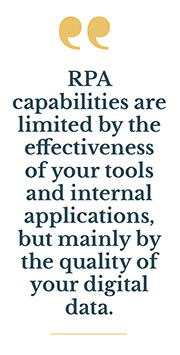Deutsche Telekom Services Europe (DTSE) is well on track with digital transformation, with a wide portfolio in this area. Starting from evangelizing digital transformation and enlarging employee digital skills and ending with dedicated Centers of Excellence (CoE). This article introduces some technologies we use in Technology Digitalization Management – Robotics CoE Team to support overall digital transformation of DTSE.
The core and engine of this process is Robotic Process Automation (RPA). RPA is an already well-established technology that has transformed the way businesses operate. With RPA, businesses can automate rules-based actions performed on a computer, allowing them to save time, reduce costs, and improve their overall efficiency.
The benefits of RPA can be summarized as follows:
- Accuracy & Quality – reduction of error rates, improved data quality
- Productivity & Efficiency – Processing (24/7) high volumes at significantly reduced time
- Compliance & Security – Increased auditability and control, compliance with security rules
- Cost saving – Reduction of processing costs by up to 80 %, ROI in a few months
- Improved delivery – Average implementation time only between three weeks to three months
- Scalability & Flexibility – Re-usable process elements
RPA is particularly beneficial for businesses that operate on multiple levels. This is because RPA can help automate processes across departments and functions, leading to more streamlined and efficient operations.
At the operational level, RPA can be used to automate repetitive and time-consuming tasks, such as data entry, invoice processing, and customer service requests. By automating these tasks, businesses can reduce errors, speed up processes, and free up employees to focus on more strategic activities.
RPA capabilities are limited by the effectiveness of your tools and internal applications, but mainly by the quality of your digital data. Therefore, one of the key factors of digital transformation is digitization. The goal of digitization is to convert analog data into digital and can be tackled from two angles. Either you create a process translating analog information and data into digital form — for example, turning a paper invoice into digital one; or by eliminating analog information completely and implementing an end-to-end digital process, e.g. replacing paper documents (e.g. contracts, invoices, payroll slips) with their digital version.
 The typical process of digitizing paper documents starts with scanning, follows by optical character recognition (OCR), to extract text from the image, and ends with converting unstructured text to structured data. In DTSE, we use smart data extraction technology, with the focus on smart. Traditionally, the conversion uses text parsing to extract relevant data. Indeed, this solution works for simple cases (e.g. one layout of contract), when you know where to locate the information on the document. But the challenge starts when you require a solution which can handle a document from hundreds of vendors with different formats, layouts, or languages. That’s the place where “smart” enters the scene.
The typical process of digitizing paper documents starts with scanning, follows by optical character recognition (OCR), to extract text from the image, and ends with converting unstructured text to structured data. In DTSE, we use smart data extraction technology, with the focus on smart. Traditionally, the conversion uses text parsing to extract relevant data. Indeed, this solution works for simple cases (e.g. one layout of contract), when you know where to locate the information on the document. But the challenge starts when you require a solution which can handle a document from hundreds of vendors with different formats, layouts, or languages. That’s the place where “smart” enters the scene.
Smart data extraction technology uses artificial intelligence and machine learning algorithms to extract relevant data from unstructured or semi-structured documents, such as invoices, contracts, and other business documents. This technology can help companies automate their data capture processes and improve accuracy, speed, and efficiency. The output in the form of structured data creates an input for your RPA process and as such allows you to eliminate manual processes (e.g. contract verification, invoice booking, data entry).
The examples of successful business cases of smart data extractions cover automated contracts data verifications, invoice data extraction followed by automated booking, or technician protocols processing.
The ideal scenario is to limit the existence of analog/paper data. If supported by law, paper invoices, contracts, pay slips, etc. can be replaced by their digital versions, which come with included structured data. This way you eliminate the potential errors driven by conversion; as well as the costs related to printing, maintaining, and storing.
One of the typical roadblocks for limiting the use of hardcopies is the need of physical signature from your employee, vendor, or business partner. We are proud that our team helped DTSE to create a paperless environment by incorporating a solution allowing users to create and store digital signatures, which can be applied to documents in a legally binding manner, thus eliminating the need for physical signatures.
The solution offers various features, such as the ability to create and send documents for signature, the ability to track the status of documents, and the ability to securely store and access completed documents. This way we digitalized documents related to areas of Human Resources, Facilities, and IT.
As every aspect of digital world, digital transformation is also driven by improvements in technology. Therefore, we constantly evaluate new solutions and new trends. We envision the increased use of advanced AI and ML technologies allowing to move RPA from rules-based process automatization into methodology-based process automatization, where decision-making will be driven by artificial intelligence, thus eliminating the need of predefined rules allowing to automate complex tasks. Let’s see, where technology brings us.
Martin Pánik, Senior RPA Engineer, Deutsche Telekom Services Europe Slovakia



Follow us